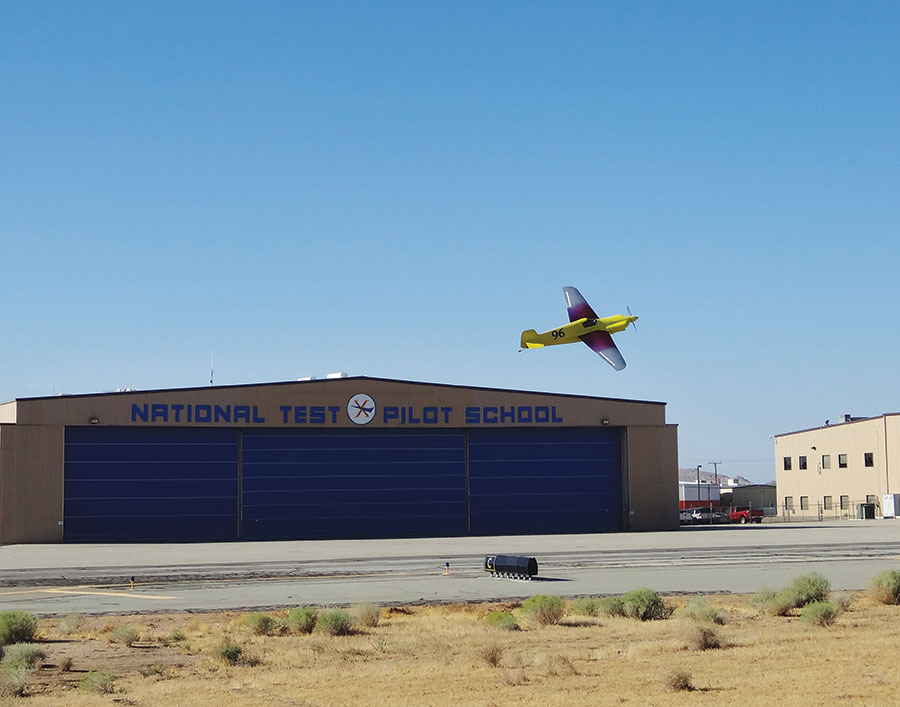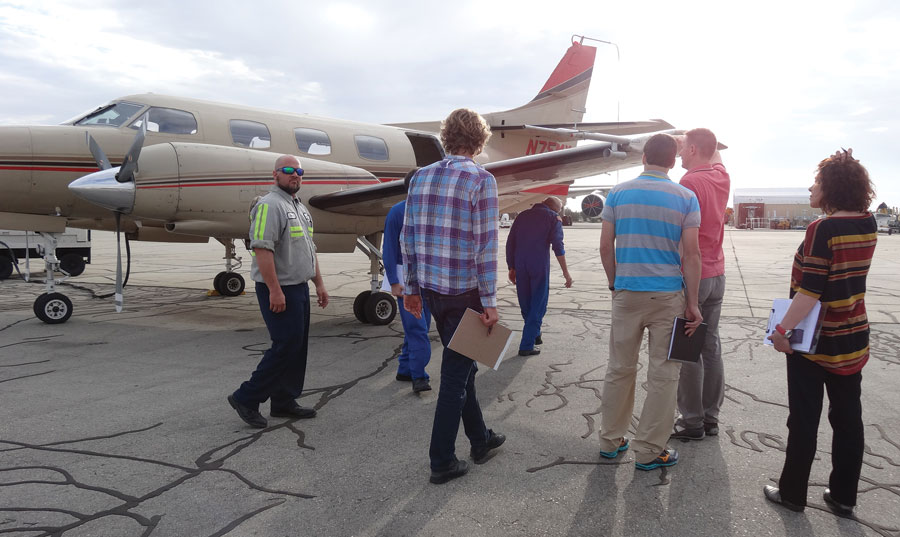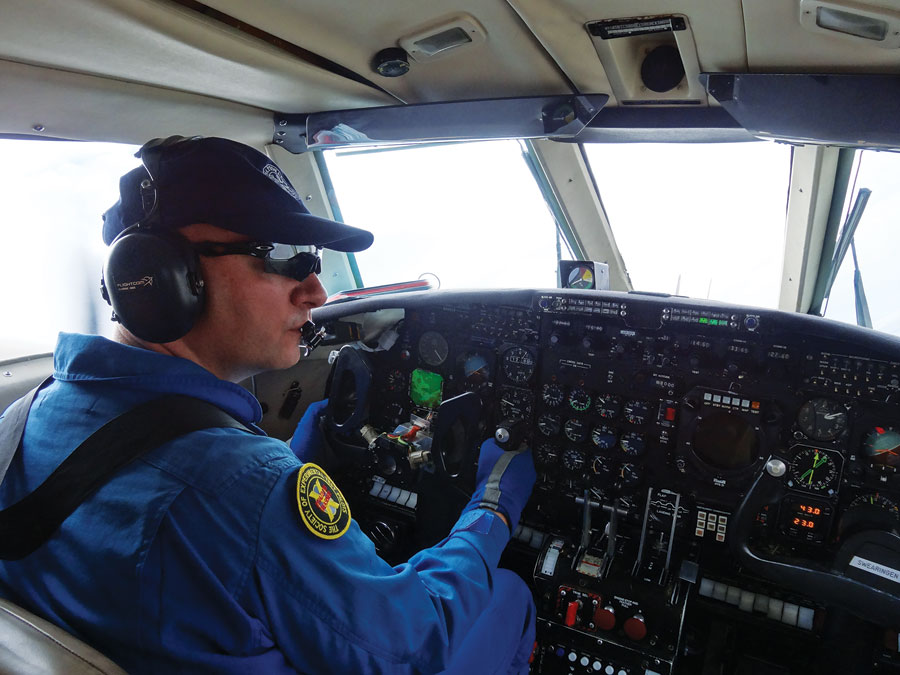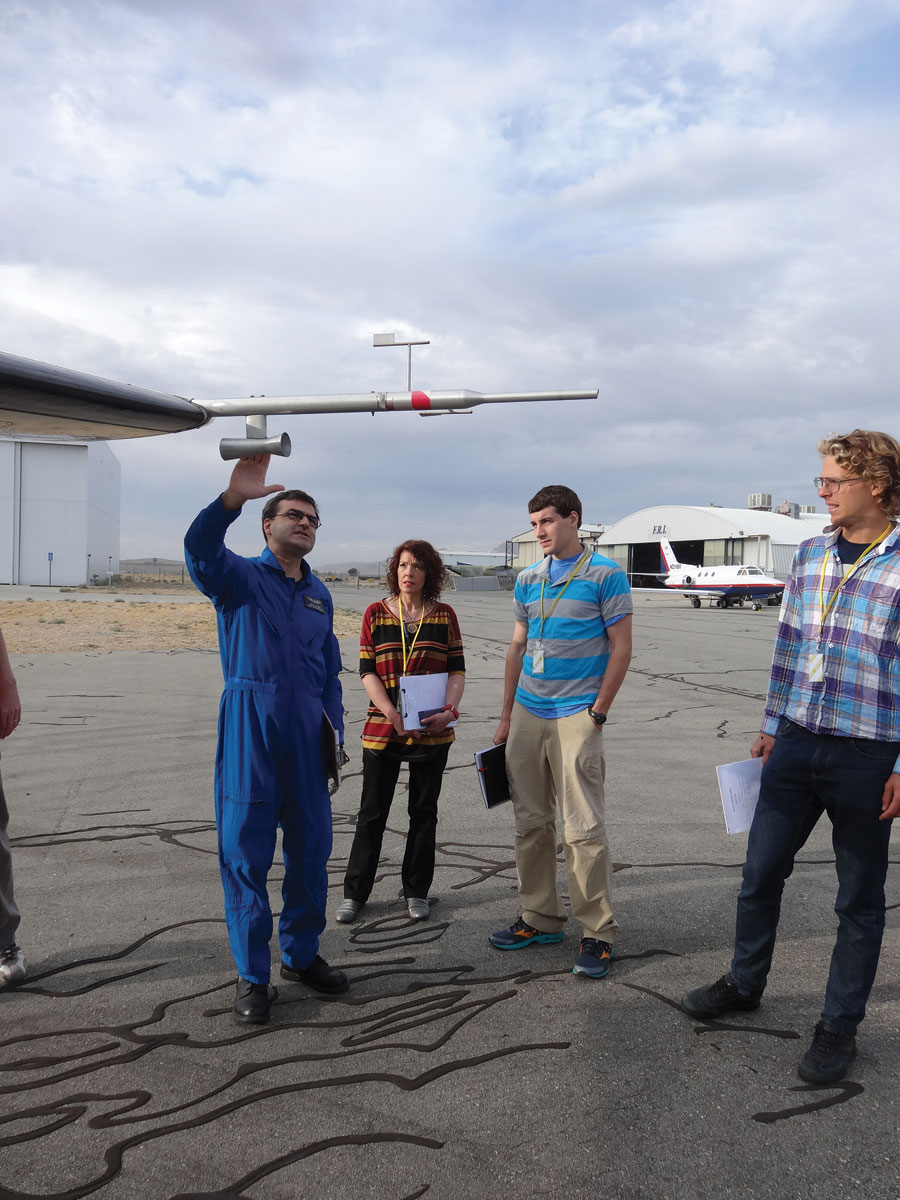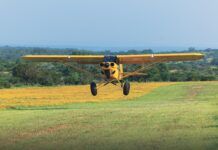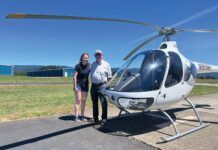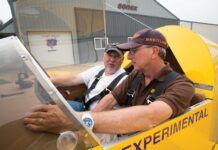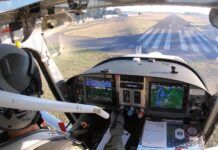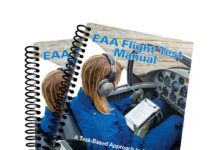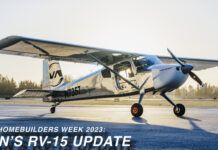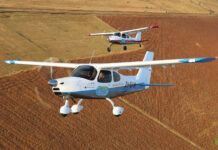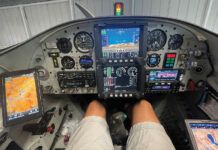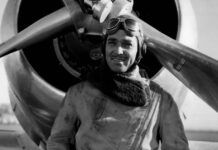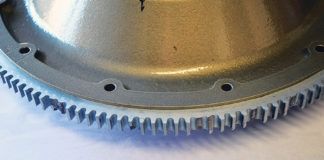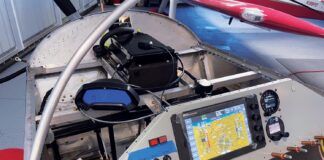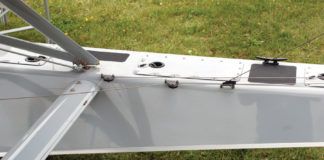RXAerosport and Wasabi Air Racing test pilot Justin “Sparkle” Gillen poses IF1 Race 4 for a photo with the NTPS logo at Mojave.
It was 8:00 in the morning on a weekday in Mojave, California. Scaled Composites’ one-off Experimental jet Proteus was testing a customer’s payload, and a Reno race team was testing their racer to prepare for a 3-kilometer record over Mojave’s civilian test center. I was sitting in the back row of a certified puddle jumper, barely looking out the window at all the activity. I had dedicated my life to Scaled Composites’ Flight Test and Reno Air Racing, but on this day I had a new challenge. I was back in school, and it was oh so much better than I remembered it.
For 10 years I had worked hard to compensate for never being formally trained in the laws that governed the airplanes I was testing. I’d read books, tested airplanes, and stood in the doorway of Scaled Composites Director of Flight Test Pete Siebold’s office until he would read the reports I had written. Now I found myself at the National Test Pilot School, surrounded by people who either wanted to learn these things as badly as I did or were there to teach them to me. It was better than I thought it could be.
The School
The National Test Pilot School is the only one of its kind on the planet, a non-military equivalent to the standard test pilot school solution. There are seven test pilot schools recognized by SETP, the Society of Experimental Test Pilots. Of those schools, six are military schools. I have only heard of a handful of civilians who were able to attend a military test pilot school and only met one. Therefore, if you missed your chance to join the military, there is only one option: NTPS.
Classroom in the sky: Students wait on the ramp while an instructor preflights the school’s Swearingen Merlin.
The trouble is the price tag. The full 50-week course costs $1 million, and yes, they can say that with a straight face (I checked). Luckily they offer short courses, intro courses, and six-week courses as well. I took the two-week “Introduction to Fixed-Wing Performance and Handling Qualities” course, and this is a summary of that experience.
The National Test Pilot School occupies the northeast corner of the Mojave Airport (near the new tower). The school’s classrooms, libraries, and offices are housed in a single two-story building. More fun are the five hangars that house the school’s airplanes (leased from Flight Test Associates). The school has 34 employees, of which 16 are instructors. As the most active user of the Mojave Airport, their operation is a well-oiled machine with a tightly orchestrated flight schedule that is the busiest I have witnessed. Their international staff is friendly and well educated, with a smiling face around every corner. Like so many attributes of the school, the facilities strike a great balance by being at once simple and subtly accurate in depth. Nothing seemed excessive or underused, and nothing seemed worn out or in need of repair, all indicators of a healthy organization.
The Students
The student body for the course was made up of industry professionals with four to 15 years work experience, all aerospace engineering majors. Of the class’s seven students, two including myself were pilots, and three including myself were Americans; Rob Kelbe came from Cirrus, and Chris Velez came from the U.S. Air Force. Four continents were represented: North America, South America, Australia, and Europe.
All the students came from organizations that valued the class very highly, making it a privilege to be sent to the school. You could sense the pride the students felt from being selected to attend the school and the pressure they were under to learn more than their co-workers who had come before them. The result was a refreshing new image of academia from what I had experienced previously. The students were engaged and motivated to get as much out of the class as they could, the instructors were proficient testers with relevant knowledge to share, and the school’s curriculum and schedule was meticulously organized to maximize the value to the student without rushing the complex material.
The course was a combination of lectures in a traditional classroom on the ground and flights in several aircraft, including the school’s Swearingen Merlin flying classroom.
Ground School
The first day of school was spent in the classroom. The day started at 8 a.m. with an introduction to the course from Gabriele De Francesco, chief of fixed-wing academic instruction for the school. Gabriele came to the school after 10 years testing fixed-wing aircraft at the Italian Air Force Center. Gabriele spent the morning whisking us through an introduction to the course that shook the cobwebs loose and (among other things) pointed out some of the school’s unique hazards: fragile and pointy pitot booms and emergency egress from the Merlin flying classroom.
The class was held in the most modern of the NTPS classrooms. It had contemporary furniture, stadium seating, a computer with a digital projector, and all the dry erase boards you would expect. The biggest differences between NTPS and my undergraduate experience were that the walls were covered with awesome flight-test artifacts, and everywhere you looked were students dressed in the uniform of their branch of service. There was also a faint odor of jet exhaust, which was awesome.
After the introduction came the dimensional analysis lecture. It was the most theoretical of all the lectures and a striking example of the brisk pace the course was going to follow. After a quick lunch, Marco Lotterio gave the subsonic aerodynamics lecture. There’s nothing like fitting three undergrad courses into an hour lecture to let you know you aren’t at your day job anymore!
Marco ended up doing the bulk of the lectures for the course. He came to the school from Calspan Corporation, where he worked on in-flight simulation and handling qualities evaluations in their fixed-wing variable-stability aircraft. Before Calspan he worked at Aermacchi doing aerodynamic parameter identification and envelope expansion on the M-346 Master, a twin-engine fighter trainer. As a result, Marco’s depth of understanding on the real-world application of modern augmented stability and the human/machine interface was like none I have encountered; it was ferociously inspiring for an all-reversible Luddite like myself.
Test pilot instructor Nicola Pecile flies simulated test points while the students observe and gather data from the instruments in the back of the Merlin flying classroom.
Airborne Learning
The school’s flying classroom is a modified Swearingen Merlin, a twin turboprop
business airplane. The Merlin is a nine-seat hot rod version of the 19-seat Swearingen Metroliner regional airliner, some 15 feet shorter with the same tail and engines. The resulting compromises make the Merlin particularly interesting for this type of test demonstration because, by design, it just meets the Part 25 certification requirements, and the handling quality fixes used to bring it into specification become very visible when the test techniques are applied.
The course’s nine flights were spread out among seven flying days. The seven core class flights were flown one per day in the Merlin and were preceded by the lecture for the associated material.
The two solo flights were flight test technique rides, designed to give the students (typically non-pilots) a chance to act as pilot in command while performing the maneuvers they had observed from the back of the Merlin during the course. The solo flights (two per student) were flown in smaller aircraft and happened while the rest of the group was reducing the data from that morning’s Merlin flight before the afternoon lectures. The result was a very fast and linear academic cadence, with an afternoon lecture and brief preceding the next morning’s data-collection flight.
Students in the Merlin’s cabin monitor flight instruments and gather data. To limit chatter, the students’ headsets had no microphone. The thumbs-up signal was used to communcate to the instructor, who would then intercom the pilot that the test point was complete.
The next day would start with an 8:00 “step to the jet” for a one-hour sortie. After landing, the group would immediately gather, as Marco would say, “while the data was still hot,” to compile data and produce charts. Then we would compare our data to the previous day’s lecture and associated theory.
All the flights had an associated school-provided spreadsheet where a student could choose to input the data and have the solution automatically derived. More industrious students could choose to do the work by hand, with or without the aid of a well-organized (also school provided) workbook, which walked the student through the operations.
Instructor Marco Lotterio shows students the air data boom on the wingtip of the school’s Merlin before the pitot-statics demonstration flight.
Pitot-Static Calibration
The first flying module was pitot-static calibration. We started with a lecture from Marco on the theory of pitot-statics on Monday afternoon. After the lecture, we were briefed by Greg Lewis, the school’s vice president and director. Before starting the engines on Tuesday’s first flight of the course, Greg looked over his shoulder and, with his Cheshire Cat grin and stone-cold delivery, asked if everyone “had their insurance paid up.” Greg is a Fellow of SETP and before NTPS (among other things), he tested the F-15 Maneuvering Technology Demonstrator (the F-15 with the all flying canards).
The Merlin flying classroom had three pitot-static systems specifically for this task. This allowed the students to use a truth source (system c) to calibrate a test system (system b) without affecting the certified primary system (system a). The coolest thing about it was each of the three systems had its own type of pitot probe, which was great exposure if, say like me, you had never seen a Kiel probe in person. The untouched certified primary system was referred to as the co-pilot’s system because it was a conventional-style probe outside the co-pilot’s window. The test system was a wingtip-mounted pitot boom, and the truth source was a wingtip-mounted Kiel probe.
For static calibration a trailing cone was installed for the flight, which was used as the truth source for the wingtip-mounted static port. Once again, it was independent of the ship’s certified system. After the flight, the data were reduced and the results were compared against Part 23, 25, and Mil-Spec standards. By comparing the data we gathered to the industry standards, we got great feedback, not only into how tight the certification standard is, but how accurate the data collection has to be to verify it.
The cruise performance (2nd) and climb performance (3rd) modules were, like the pitot-static modules, great chances to observe professionals doing the things we all do during Phase I flight testing. For the most part it wasn’t the big things that were interesting, but the details.
For instance, watching the error band that Nicola Pecile, fixed-wing and rotor-wing test pilot instructor and chief of operations, was willing to accept when performing a sawtooth climb gave me good feedback on what to expect from my own data-collection flights. He could hold the test point within half the width of the needle but, just like any of us, when he needed to read another gauge or reach cross cockpit, one-half needle width became one needle width. Like most things though, it wasn’t Nicola’s ability to hold the point that was impressive; it was the cadence and efficiency with which he moved through the card—that senior-test-pilot ability to slip points in between points and maximize the data retrieved for every hour of flight.
In general, closing the loop on what quality of data could be expected from flight test was a constant source of discussion. After a data-crunching session, the students all sat comparing stories from Saab, the U.S. Air Force, and the Argentinian FAA about what kind of repeatability and accuracy of data collection could be expected. Marco commented that an error of +/- 2% was a good rule of thumb, another fantastic tidbit to take home.
Of course, there was much more to be learned during the course. I’ll talk about the rest of the curriculum in the second part of this article.

